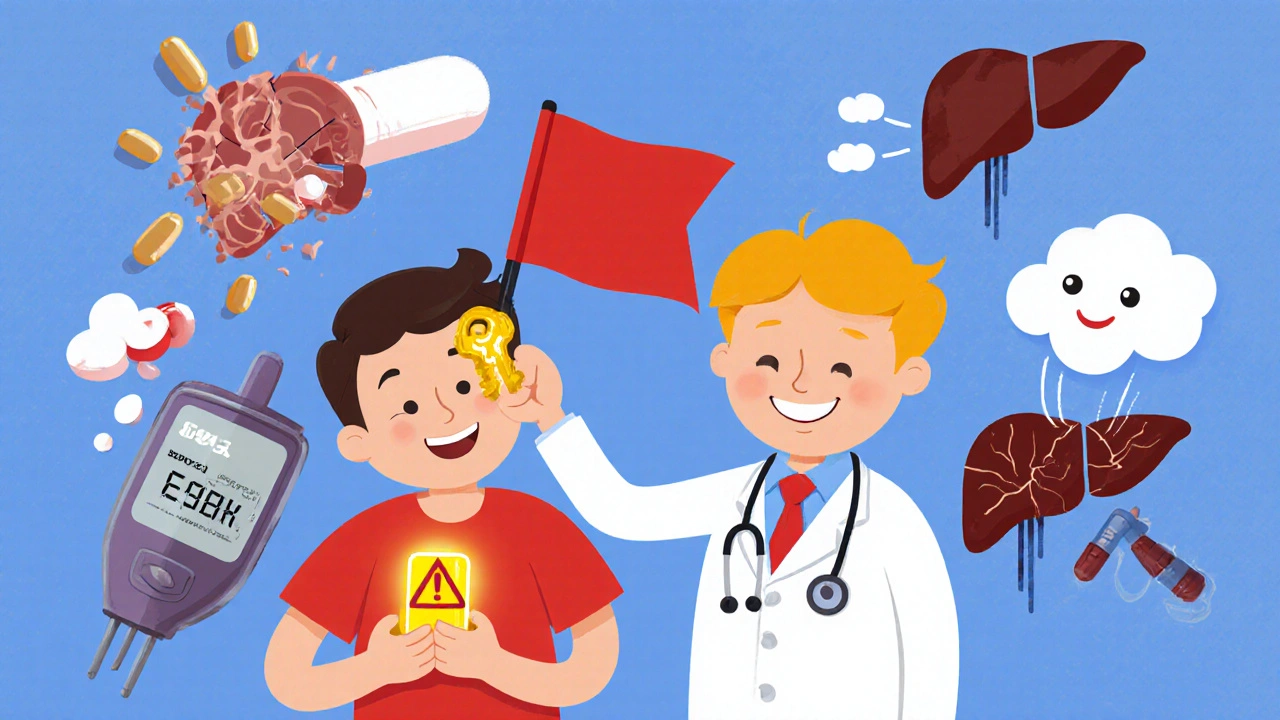Diabetes Medication Risk Assessment Tool
Risk Assessment
This tool estimates your risk of hypoglycemia unawareness when using insulin with beta-blockers based on key factors from current medical research.
Your Risk Assessment
When you're managing diabetes with insulin, your body already walks a tightrope between too much and too little sugar. Now add a beta-blocker-commonly prescribed for high blood pressure, heart disease, or arrhythmias-and that tightrope gets even thinner. You might not even know you're slipping.
Why This Combination Is Riskier Than You Think
Insulin lowers blood sugar. Beta-blockers, like metoprolol or atenolol, slow your heart rate and reduce blood pressure. On the surface, they seem unrelated. But together, they create a dangerous blind spot: hypoglycemia unawareness.
Normally, when your blood sugar drops too low, your body screams for help. Your heart races. You shake. You sweat. You feel anxious. These are your body’s natural alarms-triggered by adrenaline and other stress hormones. But beta-blockers silence those alarms. Specifically, they block the effects of adrenaline, so your heart doesn’t race and your hands don’t tremble. That sounds helpful for heart patients… until you realize you’ve lost your warning system.
Studies show that about 40% of people with type 1 diabetes develop hypoglycemia unawareness over time. That number jumps even higher when they’re on beta-blockers. And it’s not just a nuisance-it’s life-threatening. Without those early symptoms, you can go from feeling fine to passing out, having a seizure, or worse-all before you realize anything’s wrong.
Not All Beta-Blockers Are the Same
Here’s the critical detail most patients and even some doctors miss: not all beta-blockers behave the same way in people with diabetes.
Non-selective beta-blockers-like propranolol-block both beta-1 and beta-2 receptors. That means they shut down nearly all adrenaline signals, including those that trigger sweating. This leaves patients with almost no warning signs at all.
Cardioselective beta-blockers-like metoprolol or atenolol-mainly target the heart (beta-1 receptors). They’re less likely to mask all symptoms. But they still suppress heart rate and tremors, so the risk remains.
Then there’s carvedilol. It’s different. It’s not just a beta-blocker-it’s also an alpha-blocker. Research from Dungan’s 2019 study shows that carvedilol carries a lower risk of causing hypoglycemia compared to metoprolol. In fact, patients on carvedilol had 35% fewer severe low-blood-sugar events than those on other beta-blockers. Why? It doesn’t interfere as much with the body’s ability to release glucose from the liver, and it doesn’t fully block the adrenaline response.
That’s why guidelines now recommend carvedilol as the preferred beta-blocker for diabetic patients who need one-especially those with a history of low blood sugar.
What Symptoms Are Still Visible?
If your heart isn’t racing and your hands aren’t shaking, what’s left? One key signal remains: sweating.
Unlike trembling or a fast heartbeat, sweating is controlled by a different pathway-acetylcholine, not adrenaline. Beta-blockers don’t block this. So if you’re on insulin and a beta-blocker, and you suddenly start drenched in sweat for no reason, that’s your body’s last, loud warning.
But here’s the problem: many people don’t recognize sweating as a sign of low blood sugar. They think, “I’m just hot,” or “I’m nervous,” or “It’s the meds.” That’s why patient education is non-negotiable. If you’re on this combo, you need to be trained to treat sweating as a red flag-no matter the weather or activity level.

How Beta-Blockers Make Low Blood Sugar Worse
It’s not just about hiding symptoms. Beta-blockers actually make it harder for your body to fix low blood sugar.
When your glucose drops, your liver normally releases stored sugar (glycogen) to bring it back up. Beta-2 receptors in the liver help trigger that release. But when you take a beta-blocker-especially a non-selective one-it blocks those receptors. So your liver doesn’t respond. Your body can’t recover on its own.
At the same time, insulin keeps pushing your blood sugar down. You’re stuck: your body can’t raise glucose, and you can’t feel that it’s falling. This is why hypoglycemia episodes on beta-blockers are often more severe and last longer.
Studies show that in hospitalized diabetic patients, 68% of beta-blocker-related low blood sugar events happen within the first 24 hours. That’s when insulin doses are being adjusted, meals are irregular, and stress is high. It’s the perfect storm.
Who’s at Highest Risk?
You’re at higher risk if:
- You have type 1 diabetes
- You’ve had previous episodes of severe hypoglycemia
- You’re on multiple daily insulin injections or an insulin pump
- You’re older than 65
- You’re in the hospital (especially after heart surgery or a heart attack)
- You’re taking a non-selective beta-blocker like propranolol
Even if you have type 2 diabetes and take insulin only occasionally, the risk is still real. The American Diabetes Association estimates that 25% of hospitalized diabetic patients are on beta-blockers. That’s one in four. And many aren’t being monitored closely enough.
What Should You Do? Practical Safety Steps
If you’re on insulin and a beta-blocker, here’s what works:
- Ask your doctor if carvedilol is an option. If you’re on propranolol or another non-selective beta-blocker, ask if switching could reduce your risk.
- Check your blood sugar more often. At least every 4 hours during the day. More if you’re sick, stressed, or adjusting insulin doses. Don’t wait for symptoms.
- Learn to recognize sweating as your main warning. If you break out in sweat for no reason, test your blood sugar immediately-even if you feel fine.
- Use a continuous glucose monitor (CGM). CGMs have cut severe hypoglycemia events by 42% in this group. They alert you before your blood sugar drops too low-even if you can’t feel it.
- Carry fast-acting sugar everywhere. Glucose tablets, juice, or candy. And tell someone close to you what to do if you pass out.
- Don’t skip meals. Beta-blockers can mask hunger too. Eat on schedule, even if you don’t feel hungry.

What About Long-Term Use?
You might hear conflicting stories. Some studies say beta-blockers don’t increase hypoglycemia risk over years. The ADVANCE trial found no difference in severe low blood sugar between patients on atenolol and those on placebo over five years.
But here’s the catch: those were outpatient studies with stable routines. The real danger is in the short term-during hospital stays, illness, or insulin changes. That’s when things go wrong fast.
And the consequences are serious. Dungan’s research found that hypoglycemia in patients on selective beta-blockers was linked to a 28% higher risk of death. That’s not a small number. It’s why hospitals now require glucose checks every 2-4 hours for diabetic patients on beta-blockers.
The Bigger Picture: Heart Health vs. Blood Sugar Safety
This isn’t about avoiding beta-blockers. For many people-especially those who’ve had a heart attack-they’re lifesaving. The 2023 European Society of Cardiology guidelines say beta-blockers reduce post-heart-attack death by 25% in diabetic patients.
So the goal isn’t to stop them. It’s to use them smarter.
Choose carvedilol over metoprolol. Use CGMs. Monitor often. Educate yourself. These aren’t optional extras-they’re essential safety tools.
There’s no perfect solution. But there’s a clear path forward: better drugs, better monitoring, and better awareness. You don’t have to choose between your heart and your blood sugar. You just need to manage both with intention.
What’s Next? Emerging Solutions
Researchers are looking at new ways to restore hypoglycemia awareness. Early studies suggest that drugs like methylxanthines (found in caffeine) or alanine (an amino acid) might help reset your body’s alarm system. Opiate blockers are also being tested.
But the most promising area? Personalized medicine. The 2023 DIAMOND trial is studying genetic markers that predict who’s most likely to develop hypoglycemia unawareness on beta-blockers. In the future, your DNA might tell your doctor which beta-blocker is safest for you.
Until then, stick with the proven strategies: monitor closely, choose carvedilol when possible, and never ignore sweating.

